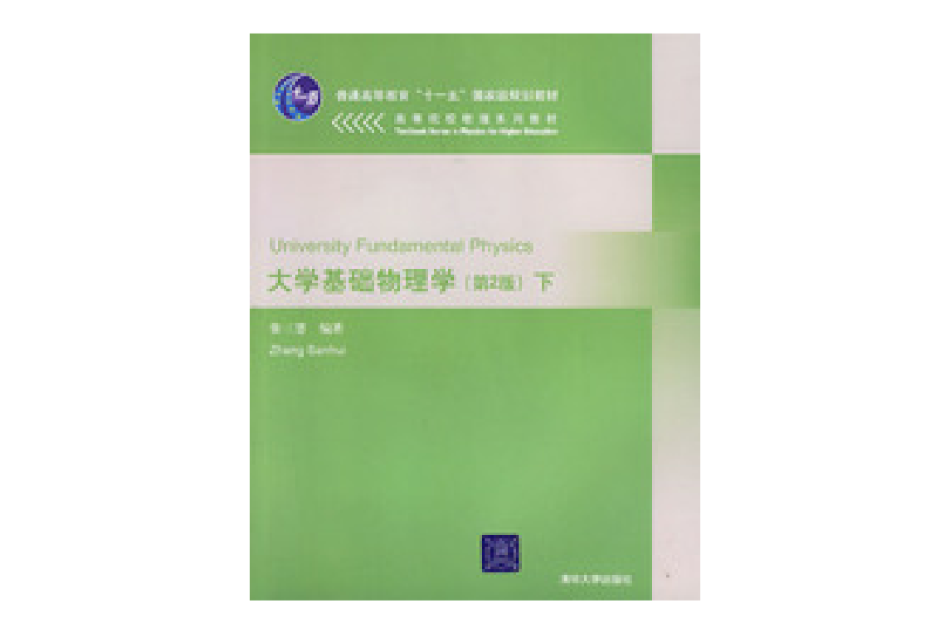《大學基礎物理學》是2010年清華大學出版社出版的圖書,作者是張三慧。

大學基礎物理學(2010年清華大學出版社出版的圖書)
相關詞條
- 大學基礎物理學(第三版)
《大學基礎物理學(第三版)》由王海嬰、羅賢清編寫,高等教育出版社出版的“十一五”國家級規劃教材,可作為高等農林院校農林類專業的教科書,也可作為其他高校相近專業40~50學時的大學物理課程的教材或參考書,亦可用作自學參考書。該...
- 大學基礎物理學(上)
《大學基礎物理學(上)》是2015年2月電子工業出版社出版的圖書,作者是鄭勇林。內容簡介 本書依據教育部非物理類專業物理基礎課程教學指導分委員會制定的《理工科非物理類專業大學物理課程教學基本要求》的框架編寫而成,全書涵蓋了基本...
- 大學基礎物理學(第二版)上
《大學基礎物理學(第二版)上》是2012年清華大學出版社出版的一本圖書 《大學基礎物理學》(第2版)分上下兩冊,上冊內容包括力學和熱學。力學篇講述經典的質點力學、理想流體的運動規律、剛體轉動的基本內容和狹義相對論基礎知識等。
- 大學基礎物理學(2010年清華大學出版社出版的圖書)
《大學基礎物理學》是2010年清華大學出版社出版的圖書,作者是張三慧。內容簡介 Volume 2 and Volume 1 cover all the pedagogic requirements of physics course in colleges and universities and hence can be used as textbooks of ...
- 大學基礎物理學(上冊)
《大學基礎物理學(上冊)》是2003年清華大學出版社出版的圖書,作者是張三慧。內容簡介 本書內容包括力學和熱學。力學篇系統地講述了經典力學的基礎知識,包括動量、角動量、能量等概念、規律和相關的守恆定律,最後還介紹了狹義相對論。熱...
- 大學基礎物理學(2007年清華大學出版社出版的圖書)
《大學基礎物理學》是2007年清華大學出版社出版的圖書,作者是張三慧。內容簡介 《大學基礎物理學》(第2版)分上下兩冊,上冊內容包括力學和熱學。力學篇講述經典的質點力學、理想流體的運動規律、剛體轉動的基本內容和狹義相對論基礎知識...
- 大學基礎物理學(第3版) 下
《大學基礎物理學(第3版)下》是2017年清華大學出版社出版的圖書,作者是張三慧、阮東、安宇。 [1] 書名 大學基礎物理學(第3版) 下 作者 張三慧、阮東、安宇 ISBN 9787302455851 定價 48 出版社 清華大學出版社 出版時間 201...
- 大學基礎物理學(第二版)
《大學基礎物理學(第二版)》是2011年科學出版社出版的圖書,作者是胡玉才、汪靜。內容簡介 該書是根據高等農林院校基礎物理課的教學基本要求,結合編者多年教學實踐經驗和教學研究成果編寫的.全書共11章,分別為:物質與物體運動,振動和...
- 大學基礎物理學(第2版)F1版下
《大學基礎物理學》(第2版)F1版分上、下兩冊。上冊內容包括力學、熱學及振動和波動。力學篇講述經典的質點力學、理想流體的運動規律、剛體轉動的基本內容和狹義相對論基礎知識等。熱學篇著重在分子論的基礎上用統計概念說明溫度、氣體的...
- 大學基礎物理學(第2版)
《大學基礎物理學(第2版)》是由作者王海嬰 編,2000年高等教育出版社出版。內容簡介 《大學基礎物理學(第2版)》是教育部全國高等學校教學研究中心立項資助的“21世紀中國高等學校農林/醫藥類專業數理化基礎課程的創新與實踐”課題...
- 大學基礎物理學第二版
《大學基礎物理學第二版》是2006年1月科學出版社出版的圖書,作者金仲輝。內容簡介 本書從現代科學技術發展和培養農業現代化人才的需要出發,對原有的大學物理教材中五大部分(力學、熱學、電磁學、光學和近代物理學)的框架做了一定程度的...
- 大學基礎物理學(第二版)下
《大學基礎物理學(第二版)下》是2006年出版的一本圖書,作者是張三慧。圖書簡介 《大學基礎物理學》(第2版)分上下兩冊,上冊內容包括力學和熱學。力學篇講述經典的質點力學、理想流體的運動規律、剛體轉動的基本內容和狹義相對論基礎...
- 大學基礎物理學(第2版)下F2版
《大學基礎物理學(第2版)下F2版》是2012年清華大學出版社出版的書籍,作者是張三慧 、馬穎、詹康生、徐麗琴、梁鴻東、劉筱燕、賈蘭偉。前言 大學物理課程是大學階段一門重要的基礎課,它將在高中物理的基礎上進一步提高學生的現代科學...
- 大學基礎物理學(第3版) 上
與本書配套的《大學基礎物理學學習輔導與習題解答(第3版)》、電子教案、教師用書(電子版)均由清華大學出版社出版。目錄 編輯 第1篇力學第1章質點運動學31.1勻變速直線運動31.2參考系5
- 大學基礎物理學下冊
《大學基礎物理學下冊》是2003年清華大學出版社出版的圖書,作者是張三慧。內容簡介 《大學基礎物理學(下冊)》是《大學物理學(第二版)》的中、少學時版本。《大學基礎物理學(下)》下冊的內容包括電磁學、波動與光學、量子物理基礎...
- 大學基礎物理學(第2版)學習指導與習題解答
《大學基礎物理學(第2版)學習指導與習題解答》按照《大學基礎物理學》(第二版)的章、節、目編排,每章包含基本要求、內容提要、典型例題和習題解答四個部分,為學生學習課程內容,複習和鞏固課堂知識提供詳細而明確的指導,對於學生...
- 面向21世紀課程教材:大學基礎物理學
《面向21世紀課程教材:大學基礎物理學》是2004年12月1日高等教育出版社出版的圖書,作者是王海嬰。圖書簡介 《面向21世紀課程教材:大學基礎物理學(第2版)》是教育部全國高等學校教學研究中心立項資助的“21世紀中國高等學校農林/醫藥類...
- 大學基礎物理學(2014-2015年電子工業出版社出版的圖書)
《大學基礎物理學》是由電子工業出版社出版的普通高等教育大學物理規劃教材,分為上下兩冊。上冊由鄭勇林、楊維、趙茂娟、王曉茜、楊敏編著,2015年2月出版;下冊由鄭勇林、盧孟春、朱曉玲、劉鴻、戴松暉編著,2014年8月出版。該教材可...
- 大學基礎物理學(第2版) 上F2版
《大學基礎物理學(第2版) 上F2版》是2012年12月清華大學出版社出版的圖書,作者是張三慧 。ISBN為 9787302305552 內容簡介 本書是張三慧編著的《大學基礎物理學》(第2版)上冊,內容包括力學、波動與光學部分。力學篇講述經典的質點力學...
- 大學基礎物理學同步輔導及系統全解
大學基礎物理學同步輔導及系統全解 《大學基礎物理學同步輔導及系統全解》是2007年2月中國礦業大學出版社出版的圖書,作者是高玉斌。內容提要:大學基礎物理學同步輔導及系統全解(第2版) 上下冊合訂本 圖書目錄:目錄 ...
- 大學基礎物理學(2007年清華大學出版社的圖書)
大學基礎物理學是指張三慧所著的大學基礎物理學(第2版)下 ,出版社是清華大學出版社,書號為97完善義項87302148135。基本信息 書名:大學基礎物理學(第2版)下 書號:9787302148135 作者:張三慧 定價:34元 出版日期:2007-4-1 出版...
- 大學基礎物理學習題解答
《大學基礎物理學習題解答》是2000年中國農業大學出版社出版的圖書,作者是祁錚。簡介 物理學是一切自然科學的基礎,高新科技無不以物理學為依託,《大學基礎物理學》課程是農、林、水院校的一門重要的基礎理論課程。它在培養學生科學素質...
- 大學基礎物理學精講與練習
《大學基礎物理學精講與練習》是2019年3月清華大學出版社出版的圖書,作者是杜旭日、楊宇霖、李敏、黃曉樺、程再軍、王靈婕、林一清。內容簡介 本書為“大學物理”課程的配套教材,以內容概要與典型例題針對主教材各章節的主要知識點...
- 大學基礎物理學(第2版)F1版上
《大學基礎物理學(第2版)F1版上》是2014年出版的圖書,作者是張三慧。圖書簡介 《大學基礎物理學》(第2版)F1版分上、下兩冊,上冊內容包括力學、熱學及振動和波動。力學篇講述經典的質點力學、理想流體的運動規律、剛體轉動的基本...
- 普通高等教育“十二五”規劃教材:大學基礎物理學
胡玉才編著的《普通高等教育"十二五"規劃教材:大學基礎物理學》是根據高等農林院校基礎物理課的教學基本要求,結合編者多年教學實踐經驗和教學研究成果編寫的。全書共10章,分別為:物質與物體運動,振動和波,生物流體力學基礎,氣體動理論,...
- 大學基礎物理學同步輔導及習題全解
《大學基礎物理學同步輔導及習題全解》是2009年中國水利水電出版社出版的圖書。內容簡介 《大學基礎物理學(第2版)同步輔導及習題全解》根據清華大學出版社出版、張三慧編著的教材《大學基礎物理學》(上、下)編寫,書中對教材中各章的...
